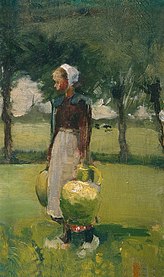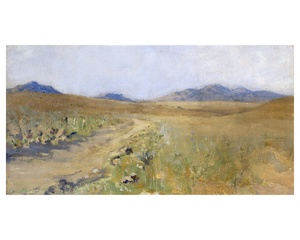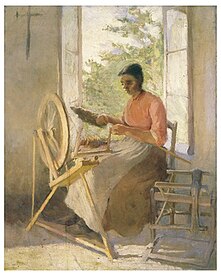Anna Huntington Stanley
This article has multiple issues. Please help improve it or discuss these issues on the talk page. (Learn how and when to remove these template messages)
|
Anna Huntington Stanley | |
|---|---|
 | |
| Born | April 20, 1864 Yellow Springs, Ohio, United States |
| Died | February 25, 1907 (aged 42) |
| Movement | American Impressionism |
Anna Huntington Stanley (April 20, 1864 – February 25, 1907) was an American Impressionist artist. She was born on April 20, 1864 in Yellow Springs, Ohio to Anna Maria Wright and General David Sloan Stanley of the US Army. She died in 1907.[1]
Her works can be found in numerous institutional collections including The Smithsonian American Art Museum.[2] An exhibition that included her work, Dutch Utopia: American Artists in Holland, 1880–1914 [3] was featured at the Telfair Museum of Art,[4] the Taft Museum of Art, Grand Rapids Art Museum,[5] and the Singer Museum.
Biography
Early life
Anna Stanley was born in a small village in Greene County, Ohio in 1864 to parents David Sloan Stanley, a U.S. Army Brigadier General, and Anna Maria Wright. She and her six siblings were primarily cared for by their mother. Due to her father's military career, the Stanley family moved several times after the end of the Civil War and lived in South Dakota, Michigan, New York, Texas and Washington, DC.
Stanley spent her high school years in New York, where she attended the Buffalo Female Academy and was lauded for her skills in drawing and painting. She received instruction under Ammi Merchant Farnham, a prominent American painter known for his landscapes. Some of his influence can be seen in Stanley's later work.
In the fall of 1882, Stanley moved to Philadelphia to continue her education at the Pennsylvania Academy of the Fine Arts, where she attended anatomy lectures and studied life drawing and sculpture under the artists Thomas Eakins and Thomas Anshutz until the spring of 1885. During this time, she also met Chicago artist Pauline Dohn Rudolph ("Lena"), who would later accompany her to Europe.
European years
In 1887, Anna Stanley, accompanied by her mother and her friend, Lena, traveled to Venice and then to Paris, where she enrolled in the Académie Julian. Several other students who had attended the Pennsylvania Academy of the Fine Arts also studied at the Académie Julian, one of them being Ida C. Haskell. At the Académie, Stanley was taught by the two renowned artists Gustave Clarence Rodolphe Boulanger and Jules-Joseph Lefebvre. Surviving family correspondence sheds light on Stanley's experiences, including details on the methodology of other artists, as well as critiques she received from their instructors. In one letter, Stanley wrote that she received "stern criticisms", but recounted that her instructors were “fair and instructive.”

In the summer of 1888, Stanley traveled to Rijsoord, a small and isolated town in the Netherlands, with several other friends and classmates. There, she stayed with the cousins of John H. Vanderpoel, an art teacher at the School of the Art Institute of Chicago, who also came to Rijsoord with the group of students to paint and teach. In Rijsoord, Stanley primarily painted scenes of Dutch farmers and laborers, women and children, and views of river scenes, dikes, and wide-open landscapes.
In the fall of 1888, Stanley returned to Paris along with her friends, and registered at the Académie Colarossi, where they received instruction from artists Jean-André Rixens and Gustave-Claude-Etienne Courtois. In May of 1889, Stanley's painting, Au commencement et à al fin, was selected for exhibition at the Paris Salon, and in June, she, along with many of the student artists, returned to Rijsoord for the summer.
Later years
Anna Stanley came back to San Antonio, Texas, in November 1889. In 1891, three of her paintings were included in the First Annual Exhibition of American Art at the Detroit Museum of Fine Arts in Michigan. By this time, Stanley had become more well known, and had her artwork exhibited in various art museums. She continued to produce works over the next several years and exhibited at the National Academy of Design, The Boston Art Club, and the Society of Washington Artists. Her work was also included in an exhibition in Washington, D.C. for the Grand Army of the Republic, a veterans’ group that formed after the Civil War.
In 1895, at her brother David's graduation from West Point Military Academy, Stanley met Lieutenant Willard Ames Holbrook, whom she would later marry. Soon after, Stanley made her last trip to Rijsoord, this time staying there for five months. Upon her return to the United States, she continued to have her paintings featured in exhibitions, including at the Veerhoff Galleries in Washington, D.C. In October of 1896, Stanley married Lt. Willard Holbrook, and subsequently moved to his post at Fort Grant, Arizona. In 1897, she exhibited The Spinning Wheel at the Society of Washington Artists, Cosmos Club, Washington, D.C., which was the last known exhibition of her work during her lifetime, although she continued to paint.
In May of 1899, Stanley gave birth to Willard Ames Holbrook, Jr, and she gave birth to David Stanley Holbrook in April of 1900. Due to her husband's position in the army, Stanley and her family moved frequently. Lt. Holbrook was stationed in the Philippines in 1900, and Stanley and her sons stayed in Washington, joining her husband in the Philippines a year later. During their residence on the island of Panay, in the Philippines, Holbrook and Stanley visited Japan and Korea, which influenced Stanley's artwork. The family returned to America and lived at Fort Huachuca in Arizona, and then at Fort Prescott from 1903 to 1905, when Lt. Holbrook received orders to teach at the Pennsylvania Military College in Chester, Pennsylvania.
On February 25, 1907, at 42 years of age, Anna Stanley died of pneumonia at her home in Chester, leaving behind her husband and her two young sons. She was buried at the United States Soldiers' and Airmen's Home National Cemetery in Washington, D.C.
Chronology

- April 18, 1864: Anna Huntington Stanley was born in Yellow Springs, Ohio. She was the fourth child of General David Sloan Stanley and Anna Maria Wright.
- 1874: The family moved to Detroit for General Stanley's military duties at Fort Wayne, MI.
- 1876: General Stanley was posted in New York, NY.
- 1878–82: Anna Stanley attended The Buffalo Female Academy.
- 1882–85, Stanley attended The Pennsylvania Academy of the Fine Arts in Philadelphia, and met students Pauline “Lena” Dohn, Anna “Page” Scott, Ida C. Haskell, and Susan J. Moody, all of whom remained lifelong friends.
- 1884: General Stanley was stationed at Fort Sam Houston in San Antonio, TX, as commanding general of the Texas Territory, and the family accompanied him.
- 1887–88: Stanley attended Académie Julian in Paris.
- May 1, 1888: Stanley exhibited charcoal drawing Portrait de Mme. E. H…: --fusain, Paris Salon.
- May - November 1888: She painted in Rijsoord, the Netherlands, with John H. Vanderpoel, Ida C. Haskell, Alice Kellogg, Page Scott and Lena Dohn.
- November 1888: Stanley began studying at the Académie Colarossi.
- May 1, 1889: She exhibited Au commencement et à la fin (also known as At each end of the Thread), Paris Salon.
- June – November 1889: She painted in Rijsoord.
- November 14, 1889: Anna Stanley arrived in New York from Rotterdam; she was resettled in Fort Sam Houston by November 30.
- April 10 – May 17, 1890: exhibited At each end of the Thread (also known as Au commencement et à la fin), and Girl Stirring Fire (also known as Dutch Girl Stirring a Fire), National Academy of Design, Annual Exhibition, New York.
- June 8 – 27, 1891: exhibited, Dutch Girl Stirring a Fire, Bringing Home the Milk (also known as The Milk Maid), Little French Sisters (also known as Two Children In Cart and The French Sisters), Detroit Museum of Art (now the Detroit Institute of the Arts), First Annual Exhibit of American Art, Detroit.
- July 5, 1891: exhibited Brevet-Maj-General David Stanley, O’Brien Galleries Chicago.
- November 21 – December 17, 1892: exhibited Busy Bee at the National Academy of Design, Autumn Exhibition, New York, NY (currently missing)
- January 20 – Feb. 17, 1894: exhibited Study of Girl (also called Girl Reading), Boston Art Club, Boston, MA.
- April 2 – May 12, 1894: exhibited Study of Girl, National Academy of Design Annual Exhibition, New York, NY.
- April 9 – 14, 1894: exhibited Portrait of a West Point Cadet (also called Cadet [portrait of David Sheridan Stanley]), Society of Washington Artists at the Cosmos Club, Washington, DC.
- December 10 – 15, exhibited The Milk Maid, Two Children In Cart Girl Reading, Grand Art Loan Exhibition, Washington, DC.
- April 23, 1895: Anna Stanley's mother, Anna Maria Wright Stanley died in Washington, D.C., and was buried at the Soldiers’ Home National Cemetery.
- June 1895: Stanley attended graduation of her brother, David, from West Point and met her future husband Lieutenant Willard A. Holbrook.
- June 22, 1895: Stanley returned to Netherlands, via New York, with Ida C. Haskell on the Holland America Line steamship, SS Spaarndam.
- November 1895: She returned to the United States.
- December 23, 1895 – January 11, 1896: exhibited Harvest – Holland (also called Girl Carrying Sheaves) at the National Academy of Design, Autumn Exhibition, New York, NY.
- March 2 – 7, 1896: exhibited Heather-covered Dunes, A North Holland Peasant, Harvest and The Hopeful Fisherman (also called The Lone Fisherman).
- April 26, 1896: exhibited Summer (also called Dutch Bride), Sand Sifter (also called Girl with a Winnowing Basket), The Road (also called Road by a Canal), The Windmill (also called Landscape with Windmills and Road by a Canal), and The Lone Fisherman (also called The Hopeful Fisherman), Veerhoff Galleries, Washington, DC.
- October 1, 1896: Anna Stanley and Lieutenant Willard Ames Holbrook, 7th Cavalry, married in the Chapel at the Old Soldiers’ Home Washington, DC.
- December 1, 1896: Stanley moved with Lt. Holbrook to his post at Fort Grant, AZ.
- April 5 – 10, 1897: exhibited The Spinning Wheel at the Society of Washington Artists, Cosmos Club, Washington, DC.
- May 31, 1898: Willard Ames Holbrook, Jr. was born Fort Grant, AZ.
- June 13, 1898: Captain Holbrook was ordered to Chickamauga, GA, and then to Cuba. Stanley visited friends and then went to Washington, D.C., with Willard Jr.
- 1899: The family moved to Fort Stevens, OR, where Lt. Willard Holbrook expanded the Fort; later the same year he was ordered to the Philippines.
- April 20, 1900: David Stanley Holbrook born on Angel Island, San Francisco, CA.
- 1900: Stanley and her sons returned to Washington, D.C., to live with her father, General Stanley, while Holbrook was in the Philippines.
- September 15, 1901: She sailed with her sons and their nanny to Manila, Philippines, to meet Holbrook.
- September 25, 1901: the family sailed to San Jose de Buenavista, Panay, where Holbrook served as the Civilian Governor.
- March 13, 1902: Stanley's father, General David Sloan Stanley, died in Washington, D.C., and was buried at the Soldiers Home National Cemetery.
- 1902: Willard Holbrook and Anna Stanley visited Korea and Japan.
- February 6, 1903: Stanley, the nanny, and the boys returned to San Francisco on USS Sheridan troop transport.
- 1903: The family moved to Fort Huachuca, AZ, and then to Fort Whipple, Prescott, AZ, where they lived until 1905.
- September 1905: Holbrook was assigned to teach at the Pennsylvania Military College, Chester, PA.
- February 25, 1907: Anna Huntington Stanley died of pneumonia in Chester, PA at 42 years of age.
Gallery
-
Summer, 1895
-
Road By A Canal, 1895
-
The Milkmaid (Study), 1888-1889
-
Arizona Landscape, 1896–98
-
Girl Spinning, 1896–97
References
- ^ "Biography". Anna Stanley. Archived from the original on 2013-07-26. Retrieved 2013-12-04.
- ^ "SIRIS – Smithsonian Institution Research Information System". Siris-artinventories.si.edu. Retrieved 2013-12-04.
- ^ Leeman, Fred (Spring 2011). "Exhibition review of Dutch Utopia: American Artists in Holland, 1880–1914". Nineteenth-Century Art Worldwide. 10 (1).
- ^ "Dutch Utopia: American Artists in Holland, 1880–1914 | Telfair Museums". Telfair.org. Retrieved 2013-12-04.
- ^ "Grand Rapids Art Museum presents Dutch Utopia : American Artists in Holland, 1880–1914" (PDF). Artmuseumgr.org. Retrieved 2013-12-04.
External links
- 1864 births
- 1907 deaths
- American Impressionist painters
- People from Yellow Springs, Ohio
- 19th-century American painters
- American women painters
- 20th-century American painters
- 20th-century American women artists
- 19th-century American women artists
- Painters from Ohio
- Académie Colarossi alumni
- Deaths from pneumonia in Pennsylvania
- Burials at United States Soldiers' and Airmen's Home National Cemetery
- Students of Thomas Eakins





